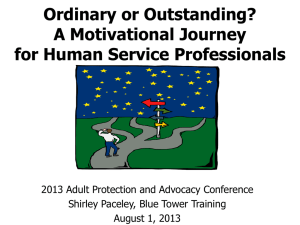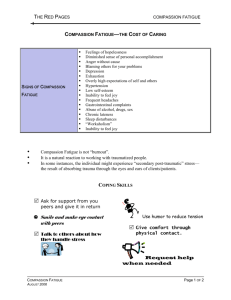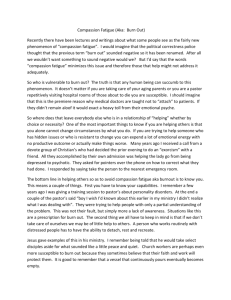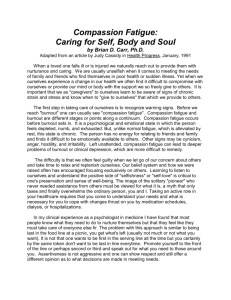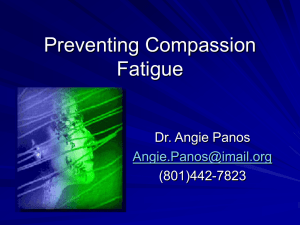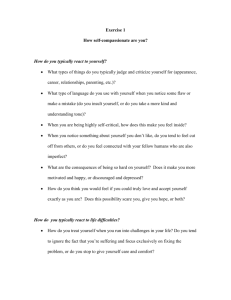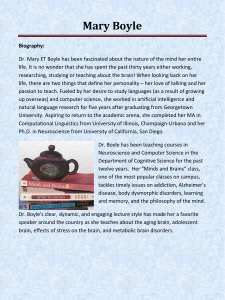Presentation file including speaker notes
advertisement
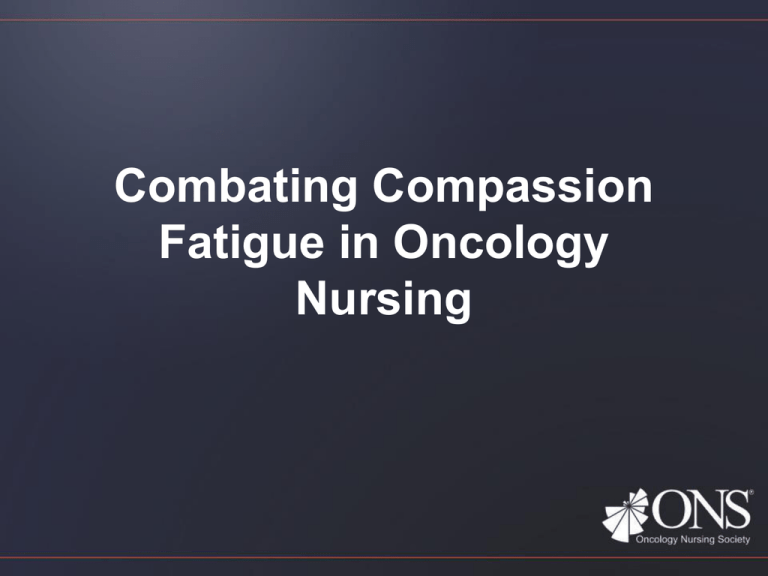
Combating Compassion Fatigue in Oncology Nursing Objectives • Describe the concept of compassion fatigue and its prevalence among oncology nurses. • Review the risk factors, symptoms and impact of compassion fatigue. • Explore available assessment tools/methods of determining the existence and measurement of compassion fatigue. • List interventions or resources available to prevent or manage compassion fatigue. Compassion Fatigue Phenomenon • “Loss of the ability to nuture” (Joinson, 1992) • Severe malaise as a result of caring for patients who are suffering (Sabo, 2006) • Evolves over time from compassion discomfort, to compassion stress, and finally to compassion fatigue (Boyle, 2011; Bush, 2009) • “Sometimes we feel we are losing our own sense of self to the clients we serve” (Figley, 1995) Nature of Oncology Nursing Work • Working with patients with serious, progressive illness • Daily experience of witnessing suffering o Repeated exposure to loss o High patient acuity and case load • Opportunity for establishing relationships over time o Patient/family under severe stress • Ethical or moral distress o Often involved in patient’s life-changing decisions • Potential traumatic emergencies o Feeling of helplessness • Family chaos o Families may project frustration onto staff (Aycock & Boyle, 2009) Core Assumptions / Misconceptions • I can ‘fix’ the issue • I should take responsibility for the outcome • If I care enough, everything will be fine • They will be grateful for everything I do • I will have enough resources to do my work • Family/friends will support and approve the time I invest in this helping work • I know what I’m getting into • I do not need help (Portnoy, n.d.) Demands of Our Work • • • • • • • • Patients Families Physicians Peers Technology Hospital Expectations Regulations Healthcare Economic Challenges The list goes on… Compassion Satisfaction – Compassion Fatigue Model (For more information: www.proqol.org ©Beth Hudnall Stamm, 2009) Compassion Satisfaction • The positive aspects of helping o Pleasure and satisfaction derived from work • May be related to o Providing care o Healthcare system o Work with colleagues o Beliefs about self o Altruism Unselfish concern for the welfare with others The belief that acting for the benefits of others is right and good Compassion Fatigue • The negative aspects of helping • Deep physical, emotional, and spiritual consumption accompanied by significant emotional pain (Joinson, 1992) • Severe malaise as a result of caring for patients who are suffering (Sabo, 2006) • Characterized by: o Deep emotional and physical exhaustion o Symptoms resembling depression and PTSD o Shift in sense of hope, optimism about the future and the value of their work (Mathieu, 2007) • Unmanaged compassion fatigue (CF) can lead to other issues (Aycock & Boyle, 2009; McSteen, 2010; Radziewicz, 2001) Risk Factors • Age • Under the age of 40 (Maslach et al., 2001; McSteen, 2010; Potter et al., 2010) • Marital Status • Unmarried or single (Maslach et al., 2001) • Work experience • years of experience • Less than 10 years • Level of educational background • Baccalaureate-prepared RNs (Buerhause et al., 2001; Maslach et al., 2001; McSteen, 2010; Potter et al., 2010) • High job expectations (Bush, 2009; McSteen, 2010; Najjar et al., 2009; Potter et al., 2010) Risk Factors • Prior personal trauma with no resolution (McSteen, 2010) • Work setting factors o Inpatient workplace setting o Overwhelming caseload and long hours o Long term exposure to those who are suffering (McSteen, 2010; Sabo, 2011) Risk Factors • Prior professional burnout experience • Personality characteristics o Inadequate coping skills o Inadequate tolerance of failure • Communication skills o Less competence in this area • Support systems o Poor peer and personal support o Limited organizational support (McSteen, 2010; Yoder, 2010) Symptoms of Compassion Fatigue • Physical • Behavioral • Emotional-Psychological • Spiritual (Radziewicz, 2001) Physical Symptoms • • • • • • • Exhaustion Gastrointestinal Disturbances Headaches Sleep Disturbances Muscle Aches Cardiac Issues Frequent Illness (Aycock & Boyle, 2009; Boyle, 2013; Figley, 1995; Gentry, Baggerly & Baranowsky, 2004;Mathieu, 2007; Radziewicz, 2001; Ruff-King) Behavioral Symptoms • • • • • Abuse of food, nicotine, alcohol and/or illicit drugs Excessive concern about patients on days off Dread of going to work Lack of joyfulness at work and/or home Inappropriate response to situation in comparison to its severity • Isolation • Issues with boundaries • Overextension issues (Aycock & Boyle, 2009; Boyle, 2013; Figley, 1995; Gentry, Baggerly & Baranowsky, 2004;Mathieu, 2007; Radziewicz, 2001; Ruff-King) Emotional-Psychosocial Symptoms • Can occur as part or separate from diagnosis of anxiety or depression – Nervousness – Sense of helplessness and confusion – Sadness – Poor judgment – Apathy – Exhaustion – Oversensitive/mood swings – Frustration – Boredom – Poor concentration – Anger/irritability – Decreased self esteem (Aycock & Boyle, 2009; Boyle, 2013; Figley, 1995; Gentry, Baggerly & Baranowsky, 2004; Mathieu, 2007; Radziewicz, 2001; Ruff-King, n.d.) Spiritual Symptoms • Lack of inner reflection & spirituality compounds CF • Spiritual disconnection • Spiritual struggle o Questioning meaning in work o Becoming angry at God o Concluding that a change is necessary (Radziewicz, 2001) Impact of Compassion Fatigue • Our health (Aycock & Boyle, 2009; Figley, 2002) • Our personal lives and relationship with others (Boyle, 2013) • Our work and/or organization (Medland et al., 2004; Yoder, 2010) • Eventually…our patients (Coetzee & Klopper, 2010; Pfifferling & Gilley, 2000; Schuster, 2013; Vahey et al., 2004) Caution Un-rescued Compassion Fatigue can lead to INTENSIVE suffering! Identification and Measurement of Compassion Fatigue Compassion Fatigue Assessment • ProQOL self-test (www.proqol.org) • Stress Diary • Life Stress Test • Self-Care Assessment The Professional Quality of Life Scale (ProQOL) • A free tool with permission of use already in place • Consists of 30 self-reported items which measure positive and negative aspects of caring • Both Compassion Satisfaction and Compassion Fatigue are measured • Well established • Easy to Use • Easy to Score (For more information: www.proqol.org ©Beth Hudnall Stamm, 2009) ProQOL Screening Tool • Helps understand the positive and negative aspects of helping • Not a “psychological test” • Not a “medical test” • Can be viewed as a screening for stress-related health problems • Can be used to track an individual’s CS and CF (For more information: www.proqol.org ©Beth Hudnall Stamm, 2009) Stress Diary • Self-monitoring helps change behavior • Keeping a stress diary for 1-2 weeks can help you identify the types of situations that are stressful for you and your responses to them • You might discover patterns of behavior that you want to change www.mindtools.com Sample Stress Diary Time Stressful Event Symptoms 8:30 am Overslept, late to work Frustration 9:30 am Unexpected meeting Mild headache 11:00 am Challenging patient Neck tension 5:00 pm Traffic delays; road work Moderate headache 7:00 pm Neck and shoulder pain Anger 7:30 pm Child behavior issue Frustration, depressed mood Life Stress Test • Review of major life events of past 1-2 years • Each event is correlated with stress points • Total Life Stress Score shows the susceptibility to stress-related illness (Lowenstein, n.d.) Self-Care Assessment • Physical Self-Care • Psychological Self-Care • Emotional Self-Care • Spiritual Self-Care • Workplace Self-Care (Saakvitne & Pearlman, 1996) Prevention and Management of Compassion Fatigue • Periodic assessment to identify and measure Compassion Fatigue level • Prevention of un-rescued compassion fatigue is key! • Management of Compassion Fatigue • Consider the five domains of wellness in selfcare strategies • Education • Workplace strategies (Aycock & Boyle, 2009) Physical Self-Care Strategies • • • • Exercise regularly Maintain good nutrition Sleep adequately Schedule preventative care and medical care appointments • Tend to your needs: haircut, massage, manicure, etc. • Set aside time to do one nurturing activity each day Mental Self-Care Strategies • Establish a routine that helps separate work from home • Learn to say ‘no’ to extra stress • Maintain a hobby • Learn to receive and not just give • Redefine success (Aycock & Boyle, 2009; Ruff-King, n.d.) Emotional Self-Care Strategies • Allow tears and laughter • Express your feelings to supportive people including peers • Grieve loss effectively • Practice positive self talk and recognize negative emotion that may bring you down • Establish coping strategies for the difficult times • Constructively express anger • Take pride in your accomplishments • Seek out activities that provide comfort • Play with children and animals (Aycock & Boyle, 2009; Emanuel et al., 2011; Fletcher,2010; Ruff-King, n.d.) Social Self-Care Strategies • • • • • • • Spend time with supportive people Widen your network by joining professional and social organizations Nurture your work and home relationships Learn to ask for help at work and at home Collaborate with others at work on a project Establish formal and informal debriefing for peer support Avoid comparing work performance with others; instead accept compliments and support for personal work ethic (Fletcher, 2010; Moya del Pino, 2012) Spiritual Self-Care Strategies • Make time for regular prayer, meditation and reflection • Self-care journal • Notice nature and spend time in it • Ready access to pastoral care staff to support nursing staff • “Blessing of the Hands” Ceremony • “Tea for the Soul” approach (Aycock & Boyle, 2009; Boyle, 2013; Fletcher, 2010; “Tea for the Soul”) Intervene With Education • Educate about Compassion Fatigue and resources available to combat it • End of Life Nursing Education Consortium (ELNEC) training • Set career goals (Aycock & Boyle, 2009; Bush & Boyle, 2012; Compassion Fatigue Awareness Project: www.compassionfatigue.com) Intervene with Work-Place Strategies • • • • • • • • • • • Consider strategies to assist with workload Provide nurse mentor/mentee opportunities Offer educational programs on subject Offer retreats to refuel / ”Day of Rejuvenation” Create a place of refuge in your workspace Provide formal arts programs to promote morale Accelerated Recovery Program On-site counseling Support groups De-briefing opportunities Bereavement interventions (Aycock & Boyle, 2009; Barnard et al., 2006; Boyle, 2011; Fetter, 2012; Hughes, 2013; Kraybill, 2003; Schuster, 2013; www.nursinglink.monster.com, 2009; www.truthaboutnursing.org, 2012) Summary • Compassion fatigue results from the care giving work of oncology nursing • “Dig where the ground is soft” Chinese Proverb • Remember why you do what you do • Take the time to identify, measure and manage compassion fatigue so you can continue to do this significant work • Organizations must recognize their role to support oncology staff References • Full list of references included with your handouts Special Thanks: Author Nancy C. Aycock RN, OCN®, CHPN Palliative Care Coordinator St. Dominic Hospital Jackson, MS Special Thanks: Expert Reviewer Nancy Jo Bush RN, MN, MA, AOCN®, FAAN Lecturer / Oncology Nurse Practitioner UCLA School of Nursing Los Angeles, CA
